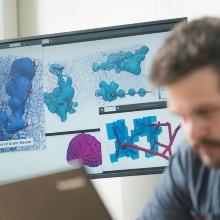Integration of Data into the Research Process
The long-term research objective of the Cluster of Excellence in Data-Integrated Simulation Science is to systematically integrate information derived from various types of data into the modeling-simulation-analysis cycle. This will give us a deeper understanding, let us obtain more precise predictions, and help us make reliable decisions. We aim to develop a new class of jointly simulation- and data-driven approaches that will boost the applicability and accuracy of simulations and fundamentally transform the way in which we do science and engineering. The resulting methodological innovations are expected to meet the great challenges facing contemporary engineering and natural sciences and, eventually, to profoundly impact many aspects of human life.
Visionary Examples and Focus Challenges
We expect that our methodological innovations will help to meet many grand scientific and societal challenges, but initially we have chosen three specific Visionary Examples to guide and motivate our research for the next 15 years and beyond. These Visionary Examples require solving a common set of methodological Focus Challenges. We have identified an initial set of six Focus Challenges to spur the Cluster on. Eventually, they will empower additional Visionary Examples, which we will address by an interdisciplinary research effort.
Interdisciplinary Research Networks
Our seven interdisciplinary Project Networks constitute the Cluster’s Research Units that provide solutions to research questions which we derived from the Focus Challenges. The overall research efforts are driven by the Visionary Examples, which, in turn, will be advanced by progress achieved in the Project Networks. Each Project Network comprises several thematically aligned projects conducted jointly by interdisciplinary teams of researchers. The Principal Investigators are grouped in Fields of Expertise, which match and cover the competencies needed for successfully tackling the Focus Challenges.



